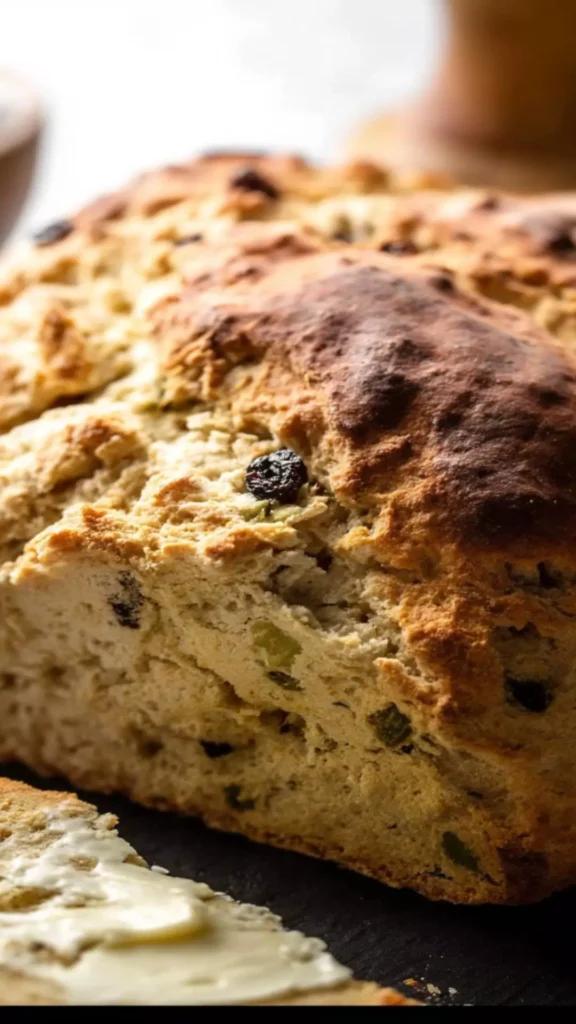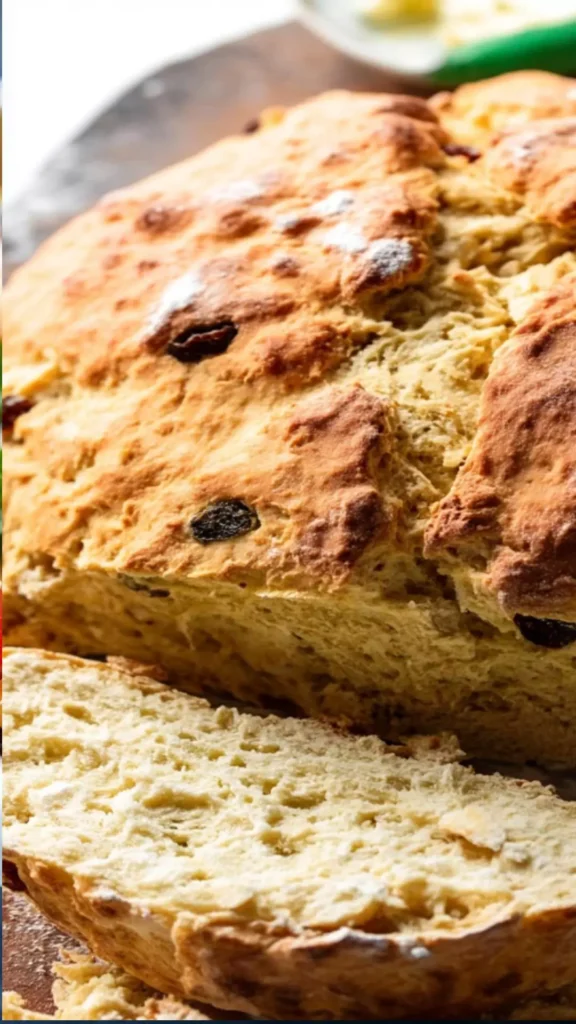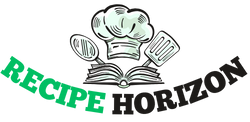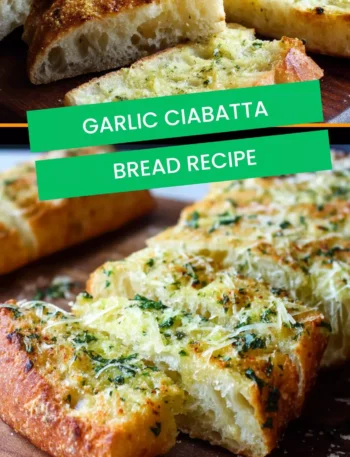Traditional Irish soda bread, with its slightly tangy flavor and crumbly texture, is a versatile bread that pairs wonderfully with a variety of accompaniments.
A classic and simple pairing is butter and jam—spread a generous layer of creamy butter on a warm slice of soda bread and top it with your favorite jam, like strawberry or raspberry, for a sweet and rich contrast.
For a more savory option, pair the bread with cheese; a sharp cheddar or tangy goat cheese complements the bread’s flavor beautifully, offering a creamy texture that contrasts with the bread’s crumbly structure.
Soda bread also makes an excellent side to soups, particularly Irish vegetable soup or a hearty potato leek soup. The bread is perfect for dipping, soaking up the flavorful broth with every bite. Lastly, for a heartier pairing, serve soda bread alongside a rich beef or lamb stew.
The firm, dense texture of the bread holds up well to these savory stews, allowing you to enjoy each flavorful bite. With these pairings, traditional Irish soda bread can easily transform any meal into a satisfying and comforting experience.

Ah, Irish soda bread—it’s more than just a loaf; it’s a slice of history and a testament to simple ingredients creating something heartwarming. Growing up, the smell of freshly baked soda bread filled my childhood home, wrapping me in a comforting embrace.
Each loaf tells a story of tradition, of families gathered around the table, sharing moments and meals.
In this article, we’ll explore the nuances of this beloved bread, why it has stood the test of time, and how you can create your own loaf right at home. Let’s embark on this delicious journey together.
What Is Traditional Irish Soda Bread?
Traditional Irish soda bread is a quick bread that uses baking soda as its leavening agent instead of yeast. This means it’s incredibly fast to make. Originating in the 19th century, soda bread became a staple in Irish households due to its simplicity and accessibility.
Unlike yeast bread, which demands time and patience, soda bread can be mixed and baked in under an hour.
Usually, it consists of flour, baking soda, salt, and buttermilk. The acidity in buttermilk activates the baking soda, causing the bread to rise. As it bakes, it transforms into a beautiful golden crust, while the inside remains soft and airy—truly a celebration of basic ingredients.
What Does It Taste Like?
Soda bread has a distinctive flavor. The buttermilk lends a subtle tanginess while the baking soda imparts a slight sweetness. When fresh from the oven, it boasts a crunchy crust that gives way to a soft, warm interior.
If you choose to add dried fruits like currants or raisins, they’ll add little bursts of sweetness that complement the bread perfectly.
Imagine spreading creamy butter over a warm slice—the combination of flavors is enough to make you savor each bite and lingering aroma.
Why This Recipe Works?
Creating a loaf of traditional Irish soda bread is straightforward, but here are some compelling reasons why this recipe is a winner.
1. Rapid Preparation: This bread comes together quickly. No kneading, no long rising times. You mix the ingredients, shape it, and it’s ready for the oven.
2. Minimal Ingredients: With just a handful of pantry staples, you can whip up a delicious loaf. No need for fancy equipment or hard-to-find items.
3. Crowd Pleaser: Everyone loves soda bread, young and old. Its hearty flavor makes it a perfect accompaniment for dinner or a delightful snack.
4. Versatile: You can enjoy soda bread plain, or you can get creative by adding herbs, seeds, or spices. The flexibility means this recipe can evolve with your tastes.
Ingredients for Traditional Irish Soda Bread
For this classic loaf, you will need:
- 1 large egg (optional)
- 2 Tablespoons honey
- 5 Tablespoons cold unsalted butter, diced
- 1 and 3/4 cups cultured buttermilk
- 1/2 teaspoon ground cinnamon
- 4 and 1/4 cups all-purpose flour (spooned & leveled), plus extra for dusting hands and surfaces
- 3 Tablespoons white granulated sugar
- 1 teaspoon baking powder
- 1 teaspoon kosher salt
- optional: 1 cup dried currants

Step-by-Step Instructions
Now that we’ve gathered our ingredients, let’s get baking!
Step 1: Preheat Your Oven
Start by preheating your oven to 425°F (220°C). This high temperature will help achieve that lovely golden crust.
Step 2: Prepare Your Baking Sheet
Line a baking sheet with parchment paper. This prevents the bread from sticking and makes cleanup a breeze. Lightly flour the parchment to ensure the bread can slide off easily once baked.
Step 3: Mix the Dry Ingredients
In a large bowl, combine the flour, baking powder, salt, sugar, and cinnamon (if using). Use a whisk to mix everything together well, ensuring even distribution.
Step 4: Incorporate the Butter
Add the diced butter to the dry ingredients. Use your fingers or a pastry cutter to work the butter into the flour mixture. You’re aiming for a crumbly texture, similar to coarse breadcrumbs.
Step 5: Add the Wet Ingredients
Make a well in the center of the dry ingredients. Pour in the buttermilk along with the honey and egg if you choose to use them. Mix gently with a wooden spoon or your hands, just until the dough comes together. Avoid overworking the dough; it should be soft and slightly sticky.
Step 6: Shape the Dough
Turn the dough out onto a floured surface. With floured hands, gently knead it just enough to form a ball. Flatten the ball slightly, aiming for about an inch thick.
Step 7: Score the Bread
Transfer the dough to the prepared baking sheet. Using a sharp knife, make a deep cross shape on the top. Don’t skip this step; it allows the bread to expand as it bakes.
Step 8: Bake
Place the bread in the preheated oven and bake for 30-35 minutes. You’ll know it’s done when the crust is golden brown and it sounds hollow when you tap the bottom.
Step 9: Cool Down
Once baked, remove it from the oven. Let it cool on a wire rack for at least 10 minutes. You want to enjoy it warm, but allow it to set a bit.
Notes
Here are some tips to enhance your soda bread-making experience:
- Don’t Overmix: It’s vital to mix just until combined. Overmixing leads to a dense loaf.
- Fresh Ingredients: Make sure your baking soda is fresh for the best rise.
- Buttermilk Substitute: If you don’t have buttermilk, mix regular milk with vinegar (1 tablespoon per cup) and let it sit for 5-10 minutes.
- Add Cornmeal: For a unique texture, consider adding some cornmeal to the flour mixture.
- Experiment: Feel free to play around with flavors—herbs and spices can give your bread a distinct twist.

How to Store the Leftovers?
To keep your soda bread fresh, store it in an airtight container at room temperature. It’s best consumed within a few days.
If you need to store it for longer, slice the loaf and freeze the pieces in a freezer-safe bag. When you’re ready to enjoy, simply thaw at room temperature or pop it in the toaster.
Sides for Traditional Irish Soda Bread
Here’s how to make your soda bread meal even better with these hearty sides:
- Irish Vegetable Soup: A classic pairing. Packed with fresh veggies, this soup is flavorful and satisfying. The warm broth complements the bread perfectly and is a traditional favorite.
- Beef and Guinness Stew: A rich, savory stew that’s a staple in Irish cuisine. The tenderness of the beef pairs excellently with the bread, perfect for mopping up the hearty sauce.
- Potato Leek Soup: Creamy and comforting, this soup enhances the pairing experience. The slight sweetness of leeks blends beautifully with the soda bread.
- Salad with Creamy Dressing: A fresh green salad with a tangy dressing provides a nice contrast to the rich flavors of the bread. Try adding some crunchy nuts for added texture.
Alternative Choices for Ingredients
You might not always have every ingredient on hand. Here are some alternatives:
- Buttermilk: Substitute with Greek yogurt mixed with a bit of water to thin, or use milk with a splash of vinegar as previously mentioned.
- All-purpose Flour: If you’re out, you could use whole wheat flour for a denser bread, or even gluten-free flour blends specifically designed for baking.
- Butter: Coconut oil or vegetable oil works in a pinch. Just melt it first to incorporate it better.
- Sugar: Brown sugar can be an excellent alternative, adding a slight caramel flavor to the bread.

Traditional Irish Soda Bread Recipe
Ingredients
Equipment
Method
- Start by preheating your oven to 425°F (220°C). This high temperature will help achieve that lovely golden crust.
- Line a baking sheet with parchment paper. This prevents the bread from sticking and makes cleanup a breeze. Lightly flour the parchment to ensure the bread can slide off easily once baked.
- In a large bowl, combine the flour, baking powder, salt, sugar, and cinnamon (if using). Use a whisk to mix everything together well, ensuring even distribution.
- Add the diced butter to the dry ingredients. Use your fingers or a pastry cutter to work the butter into the flour mixture. You’re aiming for a crumbly texture, similar to coarse breadcrumbs.
- Make a well in the center of the dry ingredients. Pour in the buttermilk along with the honey and egg if you choose to use them. Mix gently with a wooden spoon or your hands, just until the dough comes together. Avoid overworking the dough; it should be soft and slightly sticky.
- Turn the dough out onto a floured surface. With floured hands, gently knead it just enough to form a ball. Flatten the ball slightly, aiming for about an inch thick.
- Transfer the dough to the prepared baking sheet. Using a sharp knife, make a deep cross shape on the top. Don’t skip this step; it allows the bread to expand as it bakes.
- Place the bread in the preheated oven and bake for 30-35 minutes. You’ll know it’s done when the crust is golden brown and it sounds hollow when you tap the bottom.
- Once baked, remove it from the oven. Let it cool on a wire rack for at least 10 minutes. You want to enjoy it warm, but allow it to set a bit.
Nutrition
Notes
- Don’t Overmix: It’s vital to mix just until combined. Overmixing leads to a dense loaf.
- Fresh Ingredients: Make sure your baking soda is fresh for the best rise.
- Buttermilk Substitute: If you don’t have buttermilk, mix regular milk with vinegar (1 tablespoon per cup) and let it sit for 5-10 minutes.
- Add Cornmeal: For a unique texture, consider adding some cornmeal to the flour mixture.
- Experiment: Feel free to play around with flavors—herbs and spices can give your bread a distinct twist.
Tried this recipe?
Let us know how it was!Frequently Asked Questions
Conclusion
Making traditional Irish soda bread is more than just baking; it’s about connecting with history and taste. With accessible ingredients and easy steps, anyone can enjoy the robust flavor of this timeless bread.
Whether it’s slathered in butter and jam or served alongside a hearty stew, every bite is a celebration of Irish heritage.
The next time you want to impress family or friends, remember—nothing beats the smell of fresh soda bread wafting through the kitchen. Enjoy the journey from mixing bowl to table, and rest assured, each slice carries with it heartfelt tradition.
Now it’s your turn to grab that apron, roll up your sleeves, and dive into the delightful world of soda bread. Happy baking!




